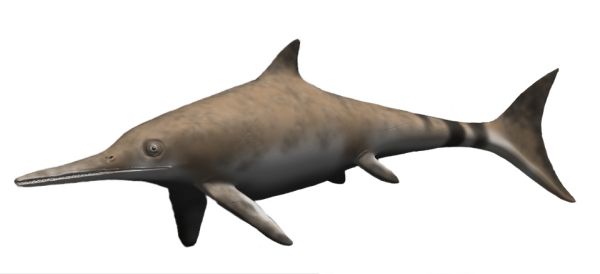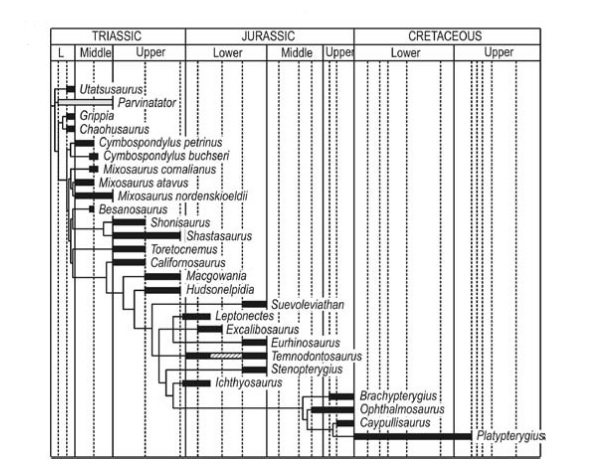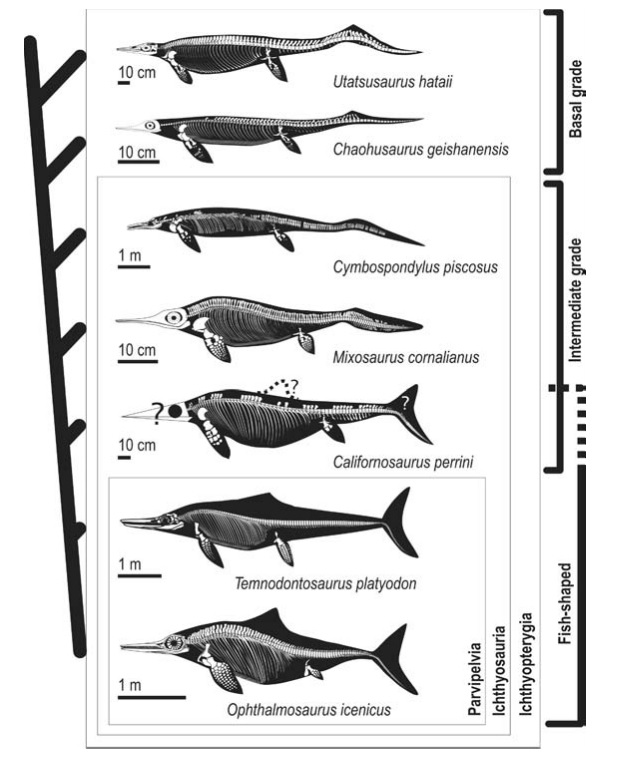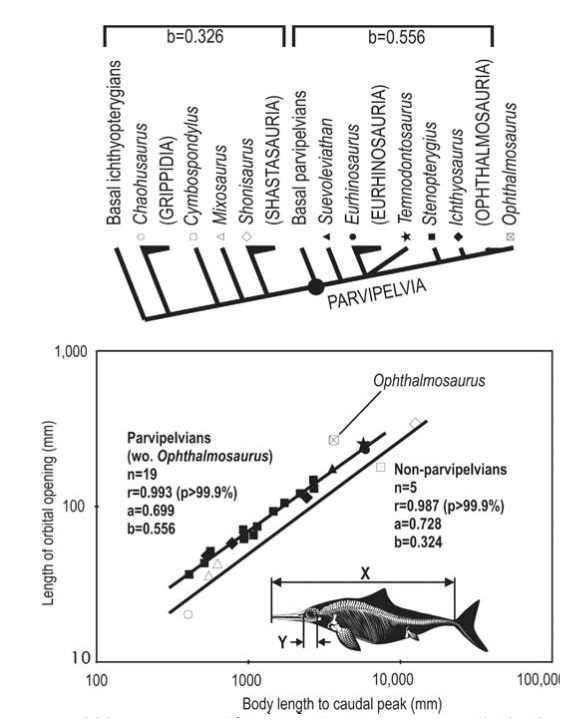If you have even a casual interest in dinosaurs and other critters from the Mesozoic, then you know what an ichthyosaur is. If not, then here’s a drawing of one.

Author: Nobu Tamura (http://spinops.blogspot.com)
This is not a fish. It’s a reptile. It may be a dinosaur, but the jury is still out on that. But it’s definitely a reptile. Just like the modern mammls of cetacea, pinniped, sirenia, and some species of carnivora (notably the sea otter) , the ichthyosaurs were once terrestrial, but went back to the sea. They evolved.
Originally, I had found an article by Dr. Erin Maxwell (a paleontologist) about the evolution of a new structure in fishes [1]. This was obviously very interesting to me, since creationists say it can’t happen. Then, I discovered another paper she wrote about the icthyosaurs, which led me down another rabbit hole and, after some communication with Dr. Maxwell, led to the paper I want to talk about today [2].
But first, sadly, I tend to frame things as if debating creationists. It’s become an annoying habit and I will try to resist as much as possible. Instead, I want to enjoy this paper for the beauty and depth it conveys about science, evolution, and the shocking world that only a few realize even exists.
As I mentioned, even a casual student of the period of dinosaurs (The Mesozoic, ranging from about 252 million years ago to 65 million years ago when almost all the dinosaurs and much of the other species on the planet went extinct) knows what an ichthyosaur is. What most probably don’t know (I didn’t and I study the period… a lot) is that there are known to be over 80 species in 36 genera. Some estimates place the number as high as 235 species in 76 genera. As a side note, there are only 90 species in cetacea (whales, dolphins, and porpoises).
What’s even better is that ichthyosaurs have some very unusual and highly evolved traits. Some species have eyes as large as 25 centimeters (that’s about 10 inches). Humans have three bones in our tetrapod digits, some ichthyosaurs have 20 in the same tetrapod digit. Some even have extra digits… up to 10 [3].
It’s no secret that I love cladograms. Here’s another one. It’s from the paper.
This one is based on the first rigorous (that is statistically based on 105 morphological traits) cladogram published for ichthyosaurs in 1999 [4]. Note that Ichthyosaurus itself is a fairly early version, living in the early Jurassic.
Now, if we look at the actual specimens, we should see that the ones in the early Triassic are more primitive than the later ones in the Cretaceous. Now, “primitive” has a special meaning in biology. It doesn’t mean stupid or weak or anything else. It means having a trait that is like the first or earliest representative of a group.
For example, humans have primitive hands compared to a horse. Our hands are very similar to the earliest tetrapods (five digits). While horses have evolved a much more unique limb (one primary digit and one or two others that are so reduced as to be almost invisible. The word primitive should always be used to compare to organisms and should refer to specific parts of those organisms.
I should add here that there are many uses of the word and I’m almost sorry I brought it up. In this case, I will use the word basal, which means the earliest clade (“group” loosely) of a given taxonomic rank to branch. It has it’s problems too and now I am sorry I brought the whole thing up.
Regardless, we should see changes from those earliest ichthyosaurs to the more recent ones. Those changes should reflect better adaptations to their environment, that is, the ocean. Interestingly, that’s what we see, when looking at the fossils.
This isn’t everything on the first cladogram and it’s a very simplified cladogram. But you can see the basic body plans. The size of the organisms increased and they became much more fish-shaped. The caudal fin becomes much more pronounced. Note also, the gradual reduction of the rear limbs and the increase in size and bones in the forelimbs. That’s what you would expect from an organism that lives in the ocean (and is a predator). Fish look like this because it works so very well.
Creationists would have us believe that organisms just appeared, fully formed. I’ve quoted from “Of Pandas and People” before. That creationist/Intelligent Design text book explicitly states that fish appeared fully formed with fins and birds appeared fully formed with feathers. We know the latter isn’t true and that seems to have missed the ichthyosaurs (and whales and horses and humans and every other group that we have plenty of fossil evidence of).
Sorry for the digression, back on target.
The fish-shaped ichthyosaurs probably evolved in the early Triassic and there seems to be new fossils that support this. Fish-shaped, as used in the paper, means a streamlined body and a obvious caudal fin (the back one that propels the organism).
Here I would like to point out something very interesting. Note that ichthyosaurs have vertical caudal fins where cetaceans have horizontal caudal fins (called flukes). There’s a very good reason for that. Fish, you see, move side-to-side. That’s where the major muscle groups are. Reptiles follow this pattern. Watch a crocodile or lizard “running” and they will flex side to side. So it makes sense that a marine reptile will also move side-to-side.
Mammals on the other hand, have developed a up-down motion for movement. Watch a slow-motion video of a cheetah running. Its back flexes up and down. It makes sense, evolutionarily, that whales (which are descended from mammals) flex their bodies up and down. A vertical fluke would be at worse, useless and at best, very inefficient. The horizontal fluke matches what we would expect from a mammal moving into the ocean. I’ll note that pinnipeds (seals, sea-lions, walruses and the like) have the exact same horizontal tail, even though they are not closely related to cetaceans at all. The closest modern relative of the whales are hippopotamuses and the closest relative of the pinnipeds are either weasels or bears (links to papers supporting one or the other), both caniforms.
The paper describes, in some detail, the various fossils and such. I’m not going into that here. It’s very cool though.
I mentioned that some of the ichthyosaurs had huge eyes. That’s another trait that, very obviously, shows an evolutionary trend.
So what this diagram is showing us is the ratio of body length (not including the tail) and the orbital diameter. The diagram specifically mentions the parvipelvians, these are the more recent ichthyosaurs that have that tuna-shaped back end. From a wide body, the animal narrows to a very thin attachment point right before a large caudal fin.
Now, the parvipelvians have a very specific ratio of body length to eye diameter. That’s all the black symbols on the top line. The non-parvipelvians have a lower ratio. Then there’s Ophthalmosaurus. First, notice where that species is on the cladogram. Yes, the furthest to the right. Then look at where he is in the time/cladogram above. Yep, one of the most recent ones. Then look at where he is, all by himself, on the length chart. Finally, take another look at his name and predict what unusual trait he’s going to have.
Yep. Ophthalmosaurus means “eye-lizard”. It had an eye diameter of about 10 inches. Just a rough estimate, that’s the size of a person’s entire head. But what’s really interesting, is that his eye was as large as other ichthyosaurs twice his size. Based on the dimensions of the eye and the relative optical numbers and similarity to modern species, it is suggested that Ophthalmosaurus had high visual sensitivity under low-light conditions.
The paper goes on to show how swimming evolved in various ichthyosaurs by comparing them to various shark species. Since sharks have both the “basal” species that aren’t as good swimmers as some other species. Compare a nurse shark to a great white, for example. The comparison of body style and dimensions lends itself to some inferences about how the various species of ichthyosaurs swam,
Finally, the author makes some very interesting comments on using laser scanning to develop bone shapes and dimensions for phylogentic analysis.
This is a fascinating paper and I’m indebted to Dr. Maxwell for providing me a copy.
__________________
[1] Maxwell, E., Furrer, H. & Sánchez-Villagra, M. Exceptional fossil preservation demonstrates a new mode of axial skeleton elongation in early ray-finned fishes. Nature communications 4, 2570 (2012).
[2] R. Motani, EVOLUTION OF FISH-SHAPED REPTILES (REPTILIA: ICHTHYOPTERYGIA) IN THEIR PHYSICAL ENVIRONMENTS AND CONSTRAINTSAnnual Review of Earth and Planetary Sciences 33 (2005), doi:10.1146/annurev.earth.33.092203.122707.
[3] All tetrapods started with four limbs (tetra means four and pod means foot). Many species have lost some of those. Horses have lost a few digits and have greatly reduced others. They are basically walking on their middle finger. Snakes have obviously lost all four limbs, but you can rarely find a snake with vestigial back legs. Whales have also lost their back legs, but again, you can find some with vestigial back legs. Nevertheless, they all started with the same plan, four limbs, five fingers at the end of each limb.
[4] Motani, Ryosuke. “Phylogeny of the Ichthyopterygia.” Journal of Vertebrate Paleontology 19.3 (1999): 473-496.



